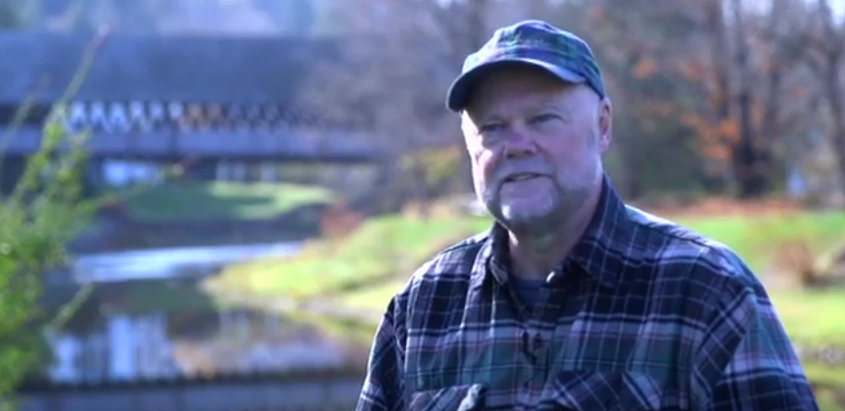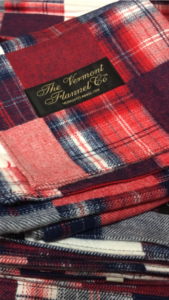
Cuddle up with company’s comfy American-made shirts, blankets, scarves, sleepwear and more.
Mark Baker likes to say, “Vermont and flannel go together like bread and butter.”

The 64-year-old entrepreneur, along with his wife Linda, are the owners of the Vermont Flannel Company, which manufacturers just about any type of clothing you can think of out of thick, soft, top-quality flannel.
“It’s part of our life up here in Vermont,” Baker said. “It’s part of our heritage. Flannel has been part of the landscape of farmers and the people out tapping the maple syrup trees. They wear those flannels. It represents an area that is beautiful and has a lot of hard-working people that know how to survive winters.”
With winter months on our doorstep, it is no wonder sales have been steadily increasing.
“On CyberMonday this year we had our biggest day in the history of the company, sales wise,” Baker said.
But business wasn’t always so successful for the Bakers.
In his younger days, Mark was in the T-shirt business, facing stiff competition while trying to get his products in department stores like J.C. Penney and Sears. He took his most popular T-shirt, an anti-Saddam Hussein garment that came out during Operation Desert Storm, to America’s biggest T-shirt trade show in Atlantic City. But before the show even began, the war ended.
“As soon as the war ended, it quickly became half-price everywhere and I wasn’t going to get Sears or J.C. Penney to buy this shirt no matter what,” he recalled.
In the meantime, Baker had made a sample of a flannel, short sleeve T-shirt and a pair of flannel pants. At that time, flannel was mostly being used for sleepwear. A pair of flannel pants would have been pajama bottoms that you wouldn’t wear outside.
But Baker’s designs were unique. “I am the guy that invented flannel lounge pants. I was the first person in the world to make them,” he recalled.
“I went to the T-shirt show and I brought my flannel T-shirt, my flannel lounge pants, a flannel gold shirt, a flannel hooded pullover, flannel shorts and just flannel everything. That’s the history of how I started Vermont Flannel Company,” Baker said.
“This was a T-shirt show, and for the first two days, everybody literally laughed at me for bringing flannel clothing to the show. By the third day, people were asking for samples and my first great mistake was sending samples to J.C. Penney, Sears and other companies,” Baker added. “Within 10 weeks of sending the sample to JC Penney, they had the exact same pair of pants to the stitch and design in over 500 stores.”
The only difference is the JC Penney flannel lounge pants were made in China, going against the Bakers’ strict philosophy of Made in America.
“Our retail prices are competing with the stuff made in China and even less if you go online. You’ll find out prices are lower than some of these so-called name-brands where you look at the label and it says it is made in China and they are charging three times more than what I charge.” Mark Baker, Vermont Flannel Company
In 1991, the Bakers opened their first brick and mortar store in Vermont. Today, they have five retail outlets. They own three small manufacturing facilities in Vermont and get additional production help from two companies in Massachusetts. Sales were up and down for the first nine years, with both good months and others that put the company in jeopardy of closing. Sales were sustainable in the early 2000s — but 2007 is when Vermont Flannel Company really took off.
“It’s kind of funny. It really started exactly when we had the great stock market crash of 2007 and the world was going to end, Chrysler was going bankrupt,” Baker said. “All the stores had 50 to 75 percent off everything. This was just before Christmas and they were just trying to get rid of everything.”
But Baker had a better idea. He opened a small kiosk in the mall next to Santa Claus. He was met with the same requests of what his sale price was for the warm, inviting flannel. He told potential customers that there is no sale price and that his flannel was reasonably priced and Made in the U.S.A.
“If these other companies would have done Made in U.S.A. we wouldn’t have this problem right now,” he said. “I literally put up big signs around my kiosk that read, ‘Made in U.S.A., Do You Give a Stitch?’
Despite not offering a discount, his sales increased. Since then, he’s been promoting the quality of his flannel products. It is hand cut and sewn and the stripes are matched the old-fashioned way. And it is super soft material.
The Bakers are enjoying ongoing success with online sales increasing as much as 40 percent over the past five years. Believe it or not, people wear flannel in California and Florida, too.
But Baker wants to do more for the American-made movement. Everything about his flannel clothing connotates Made in America except for the fabric.
‘The sad news is there are zero yarn-dyed woven flannel factories left in the United States that can do what we are doing,” he said. “I have my fabric custom made for me so it’s thicker, heavier, brushed on both sides and fits my custom patterns.”
What makes Vermont flannel so durable and comfortable is each yarn is dyed separately and then it’s woven with each thread interacting with each other. The threads become thick and it goes through a brushing machine that pulls a little bit of fiber out after it’s woven so it is fuzzy and soft.
Baker would like nothing more than to source his fabric from a company in the United States.
“I have to pay a duty fee on my fabric. These duty fees were meant to protect American companies. But all this is doing is hurting my American-made company where I have stuck with Made in U.S.A. since 1991. So, I have to pay almost 8 percent just to bring in fabric supposedly to protect American companies. But there is no American company making yarn-dyed flannel,” he said. “It’s a real unjust duty. I’d like to have a bill passed in Congress to eliminate this unfair duty but getting a bill through Congress these days is a hard thing to do.”
Vermont Flannel Company employees 45 people at its manufacturing facilities and in three of the five retail stores cut and sewers are making flannel products right in front of the customers.
“It’s not like when you go to a Polo factory outlet where the factory is in China,” he said. “This is the real thing. Our retail prices are competing with the stuff made in China and even less if you go online. You’ll find out prices are lower than some of these so-called name-brands where you look at the label and it says it is made in China and they are charging three times more than what I charge.”
But Baker, who lives in the small city of East Barre, Vermont, is happy with his hard-fought success and is 100 percent committed to Made in America.
“We are kind of a family company,” he said. “My wife and I, our biggest success is we’ve raised three children and they all seem to be enjoying life. My youngest son, Luke, runs one of our retail stores, my oldest son works for a big computer company in New York and my daughter is an engineer in Bozeman, Montana. So, after a long struggle, Vermont Flannel Company has been very good to us.
“The big designer companies are moving their production from China to Africa these days because the $3 per day wage in China is cutting into their enormous profits. In Africa, they can find workers for $1 per day. I find that people in Vermont would rather Buy American and support another American family, even if it may cost a bit more than products from China and Bangladesh.”
Baker has toiled since 1976 to become a success in the textile industry and his dream has come to fruition. He never wavered from Made in America quality.
But he does have a warning for his customers.
“Our Vermont Flannels are addictive and they will make you feel so good you may just quit your job and lounge on the couch,” he said.
The Vermont Flannel Company is among the picks in the 2017 Made in America Holiday Gift Guide and took part in our 10th Anniversary Celebration on Nov. 14. Visit Vermont Flannel Company online to shop for a wide variety of flannel clothing just in time for the holidays and those frigid winter months.
